Yesterday’s live coverage of the Ukraine conflict can be found here. An archive of our liveblogs can be found here. For an overview and analysis of this developing story see our latest podcast.
Please help The Interpreter to continue providing this valuable information service by making a donation towards our costs.
View Ukraine: April, 2014 in a larger map
For links to individual updates click on the timestamps.
For the latest summary of evidence surrounding the shooting down of flight MH17 see our separate article: Evidence Review: Who Shot Down MH17?
Below we will be making regular updates so check back often.
A little over an hour ago things looked like this.
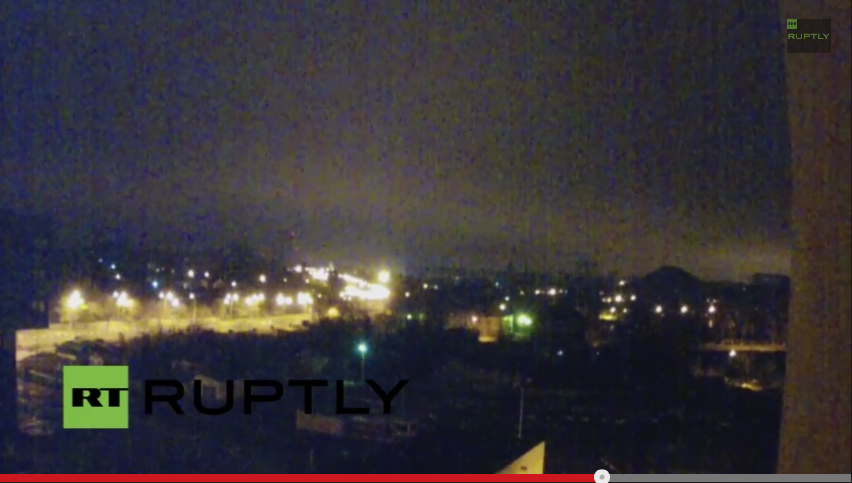
Then suddenly some of the lights go off, and there is a flash (we think to the north) which then fills the sky:
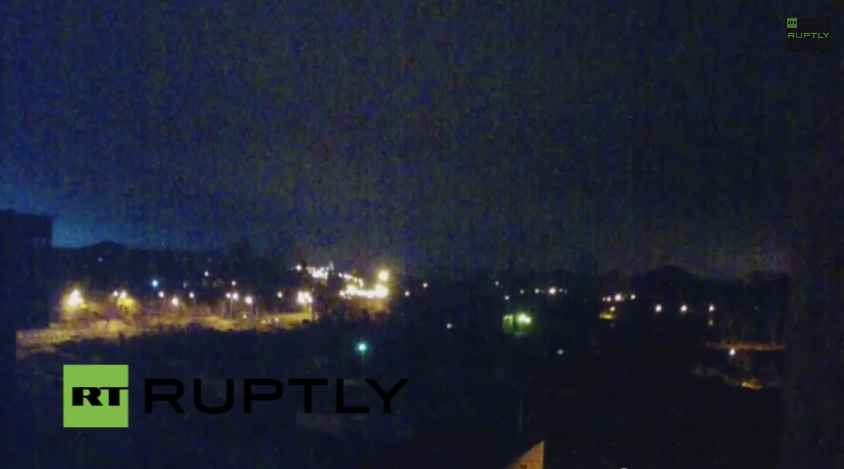

The camera freezes. When it comes back, this is the scene:
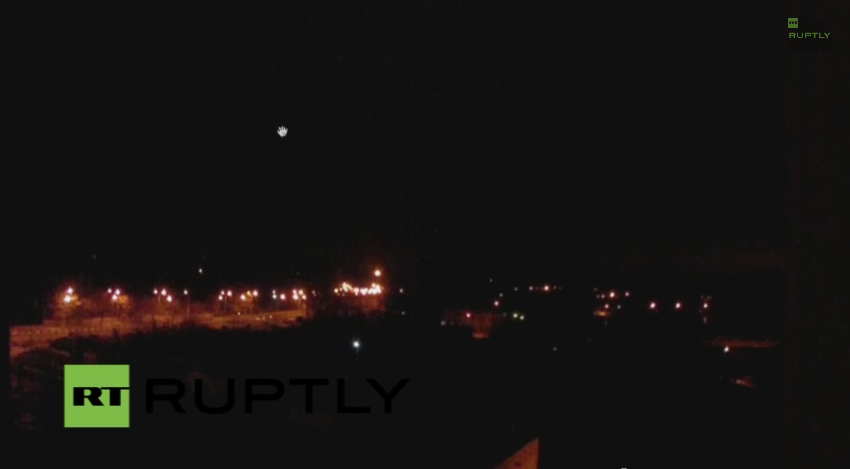
The lights have still not come all the way back on.
Clearly, the power outage froze the camera, but we did not notice a loud sound. It’s also strange that the flash, which traveled from (we believe) north to northeast, did not fill the screen instantaneously.
We’re still not sure what the cause of this flash is.
Translation: Donetsk now. They’ve really bombed it. The light has gone out all over Kiev District, then there was a hellish flash.
There is speculation that a power substation has been hit. Other speculation includes a possible explosion at a gas station. We have to caution that at this moment all these reports are unconfirmed, but something big has happened near Donetsk airport.
The BBC reports that NATO spokesperson Oana Lungescu has told reporters at a briefing in Brussels this afternoon that comments today by Dmitry Peskov, Vladimir Putin’s spokesman, are detached from reality.
Earlier today, Peskov said that Russia wanted a “a 100% guarantee that no-one would think about Ukaine joining NATO,” and that the military alliance was “attempt[ing] to break the… balance of power”.
— Pierre Vaux
This week, a new video was released which shows the wreckage of Malaysian Airlines Flight MH17 just moments after the crash. The video provides insight into the horror of the immediate aftermath and the terror of having an aircraft crash in one’s back yard, but it also provides an interesting data point. At one point, someone says “a rocket took off…and exploded it” (see Translation of New AP Video of First Moments After MH17 Crash). Following up on some questions from BBC’s Kriszta Satori, we have gone back to analyze past videos we have posted of MH17.
One of the key factors to remember about July17th is that long before the world was aware that a civilian airliner was missing it was already clear that a plane had been shot down. It’s just that most people assumed that the plane was a Ukrainian military jet, like so many others which had been shot down. Even the separatists themselves thought that they had shot down a Ukrainian air force aircraft.
In this post we made back on July 17 (Could Pro-Russian Separatists Have Shot Down the Malaysian Airliner?)
we can see a screenshot of the post made in “Igor Ivanovich Strelkov’s
Dispatches,” a group on the popular Russian social network VKontakte.
Strelkov and his close associates had posted to this group a number of
times before, as we explained.
The post refers to “the militia,” which is the name the Russian-backed
separatists give themselves, having shot down a military aircraft
The post makes it clear that the separatists believe they have shot down another Ukrainian plane (translation by The Interpreter):
17.07.2014 17:50 (Moscow Time), Report form the Militia
In the district of Torez, we just shot down an AN-26 plane, it
is lying somewhere behind the Progress coal mine. We warned them —
don’t fly in ‘our sky.’Here is a video confirmation of the latest ‘bird fall.’ The
bird fell behind the slag heap, it did not touch the residential area.
Civilians were not hurt.There is also information about a second downed plane, apparently an SU.
The post was removed when the separatists realized that they had hit the
wrong plane, but screenshots of this post were taken and a number of witnesses saw these claims in this and other VK groups supporting the separatists.
This statement was also reported separately by Russian-state outlets and pro-Kremlin private Russian news media —
which means that they also got it from their own reliable sources
within the separatists’ camp and not just “from social media.” It makes
clear a number of points:
1. Separatists make and post video confirmation of their downing of planes.
2. They had already downed some Ukrainian planes that week, notably on July 14, which Russian media also reported on, so they expected that they had just down yet another one.
3. In previous incidents, the Ukrainian pilot would often eject and
survive the crash. Witnesses in various videos and people on these forums often have the expectation that a
pilot will be seen after he ejected.
4. LifeNews, a pro-government TV station close to Russian
intelligence agencies, reported on July 17 that “the militia reports
that they have downed a Ukrainian military aviation forces above the
city of Torez of the self-proclaimed Donetsk People’s Republic” (see
1:00 here). The footage that LifeNews aired
for that broadcast were excerpts from the same two videos described
below, credited to Sergei Sidorenko and also Novosti Novorossii, a VK
group.
We analyzed the same two videos posted by Strelkov’s Dispatches and other bloggers, and one other video, from another post on July 17. The transcripts follow:
First Man: I’m surprised. I don’t think anyone has ejected yet. They’ll eject still.
Second Man: I don’t think there’s anyone there.
First Man: Where.
Second Man: The chips are still flying.
First Man: But that’s a village over there. It fell on a village.
First Man: There’s machines over there.
Second Man: A plane fell.
First Man: I see. But it fell on a village.
Second Man: Oh, no, on the woods.
In this video, several men and women are talking to the cameraman, and a man on a motorcycle drives up.
Man on motorcycle: What’s going on, hello?
Man on motorcycle: A plane, yes?
Women: It’s a plane.
Man on motorcycle: Well, thank God.
Another man: Well, you’ll see soon.
Woman: Did you see?
Woman: So that means that likely now the pilot will eject.
Another man: Oh, no.
Another woman: It’s more likely without a…
Another Man: Beautiful! So you’re filming that on a video?
Cameraman: Yes.
Another Man: But maybe it’s not a pilot?
Woman: No, it’s a plane.
Another Man: People are all rejoicing.
Woman: Uh-huh.
Another Man: It’s still burning, it’s burning.
Another Man: So it’s from that side.
Woman: So there’s no [indistinct]?
Another woman: Nowhere.
Cameraman: There wasn’t a boom.
Another man: I heard it. It plunged. It’s lying here.
Another man: Well, it crashed.
Another woman: At first it was flying, flying…
Cameraman: There’s several parts there, do you see? At least.
Another man: Where did it fall?
Cameraman: It’s still burning.
Another woman: It’s over there somewhere.
This week BBC’s Kriszta Satori noticed an interesting piece of dialogue in this video. Taken near some houses, a man is walking in the foreground
talking on the phone, and several other people in the scene are talking
to the cameraman.
First Man: I was just walking along and over there, they downed a plane…
Woman: You see?
Second Man [on the phone]: So, that’s it, that’s it, it’s passed.
First Man: …and it fell down. Over there, where Progress is. [Progress is the name of a local coal mine located near Grabovo here —The Interpreter.]
Second Man [on the phone]: Alright, that’s it, sweetie.
Cameraman: Yes, that’s Progress.
Second Man: Alright, soon we’ll see each other and [indistinct].
First man: So, well, we came out here…see, over there
Cameraman: Uh-huh.
First Man: See? The pieces flying over there. The black over there. Something crashed.
Second Man [on the phone]: It’s a plane. A plane fell.
First Man: Over there, look! Black smoke.
Third Man: Black
Camera Man: Yes
Second Man: A plane fell.
First
Man: Something crashed over there. And there’s more, it’s falling.
Look! See, there’s black smoke. It’s falling on the slag heap, where
Progress is.
Cameraman: The job got started.
Another Man: He will come out.
First man: Look, from the direction of the slag heap, toward Krasny
Second man [on the phone]: Yes, that…but f**k, there’s, what, a residential….f**k, c**t.
First Man: Black smoke is going up. What the hell!
Second Man [on the phone]: From the other direction, somewhere.
First Man: We were just walking along and the plane fell.
Another Man: He’ll come out.
First Man: Yes, the plane fell.
Camera Man: But it fell hard, it went boom.
Another Man: Where?
Second man: [on the phone] Well, call him.
Woman: What’s going on over there, a plane?
Another woman: Yes.
Second man: [on the phone] Well, it’s probably that. Because a guy shot at it, and they hit it. They hit it.
Another man: Well, f**k.
Camera man: So they didn’t bring [it] in vain, right? [Laughs]
First man: But there’s…there’s a f**king residential area over there, shit.
Another man: Well, a plane fell. It fell.
Another man: I didn’t see it, it broke apart somehow, yes?
Woman: Yes.
Second man: Alright.
This video is perhaps the most interesting. The fact that the man on the phone says “it’s probably that. Because a guy shot at it, and they hit it. They hit it,” and the cameraman responds, “so they didn’t bring [it] in vain, right? [Laughs],” indicates that these men may not be simple witnesses. Does the statement “because a guy shot at it” from the man on the phone (who is he talking to?) suggest a certain level of familiarity with what just took place? Does “they didn’t bring [it] in vain” refer to the Buk missile which is the weapon which most likely brought down this aircraft? Were at least some of these videos taken by journalists who were working with the Russian-backed militants and so knew that an anti-aircraft missile was used to take down the aircraft?
— Catherine A. Fitzpatrick and James Miller
RFE/RL reports that Arseniy Yatsenyuk, Ukraine’s Prime Minister, has rejected Moscow’s call that Kiev dialogue directly with the Russian-backed separatists in eastern Ukraine:
Arseniy Yatsenyuk spoke at a government meeting after Russian Foreign Minister Sergei Lavrov said Moscow was calling for “establishing stable contacts between Kyiv and Donbas aimed at reaching mutually acceptable agreements.”
…
Yatsenyuk said in Russian, “We will not hold direct talks with your mercenaries.”
He called on Moscow to “stop playing games aimed at legitimizing bandits and terrorists.”
“If you want peace, fulfill the Minsk agreement,” Yatsenyuk said, referring to a September 5 agreement, which Russia signed off on, that imposed a cease-fire and set out steps toward peace.
Yatsenyuk made even more interesting tweets on the subject:
Direct dialogue between Kiev and the separatist leaders in the Donbass has been a key demand made by Moscow. In fact, the Russian government heralded the “elections” in eastern Ukraine as a a key first step in facilitating this process. But Yatsenyuk is throwing a wrench in Russia’s stated plan here. “Stated” is italicized because one could argue that political dialogue has never been Russia’s real goal.
This announcement, however, is just another sign that the political process, even if it was a farce which was doomed to fail, is falling apart. With each day there is more fighting and the ceasefire is just a memory. The question becomes, then, what will Russia do next?
UNIAN reports that Yevhen Perebyinis, a spokesman for the Ukrainian Foreign Ministry, said yesterday that several columns of Russian military vehicles have been observed crossing the Ukrainian border over the past three days.
UNIAN reports:
The columns, including tanks, artillery guns and multiple rocket launcher systems, were spotted crossing into Ukraine from the Izvaryne and Novoazovsk border checkpoints, Perebyinis said.
He said the columns consisted of more than 100 units of military hardware.
Ukrainian media sources have also reported deployments of Russian military units within Ukraine itself.
“The Russian Federation and the insurgents have formed several strike groups and mustered their military equipment and personnel near Donetsk, Luhansk and Debaltsevo,” Ukrainian online newspaper Novosti Donbassa reported.
It also said more than 500 militants, 30 tanks, three air defense missile systems, six multiple rocket launcher systems, six large-caliber howitzers and many other items of military hardware had been spotted in Dokuchaievsk, which is close to the strategically significant Ukrainian-held town of Volnovakha.
A train with twelve wagons of ammunition has also arrived in Ilovaysk, the newspaper said.
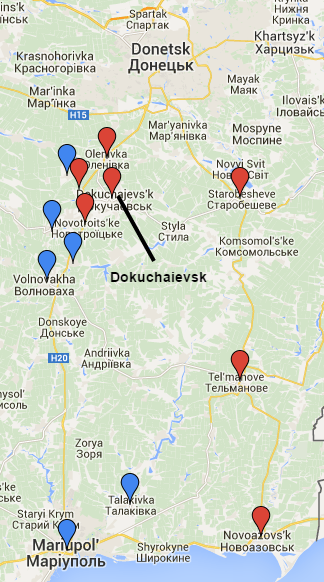
Last week, there were reports of a possible upcoming Russian offensive near Volnovakha, which lies on a strategically important highway linking Donetsk and Mariupol.
— Pierre Vaux
The BBC reports that Dmitry Peskov, President Putin’s spokesman, has told them that Russia wants “a 100% guarantee that no-one would think about Ukaine joining NATO.”
Dmitri Peskov added that Nato’s gradual approach towards Russia’s borders had made Moscow “nervous”.
Earlier, Mr Putin said the US would never “subdue” Russia over Ukraine.
Germany’s foreign minister said Europe was heading for “confrontation instead of cooperation”, amid warnings of a Russian build-up on Ukraine’s border.
During a joint news conference in Moscow with Russian Foreign Minister Sergei Lavrov, Frank-Walter Steinmeier said that as fighting escalated in east Ukraine he could see “no grounds for optimism”.
The minister also urged Russia to abide by the Minsk ceasefire agreement.
Nato has warned of a serious Russian military build-up in rebel-held territory in eastern Ukraine and on Russia’s side of the border.
But Mr Peskov countered by accusing Nato of breaking a historic promise by gradually approaching Russia’s borders.
He said the alliance was “attempt[ing] to break the… balance of power”.
Last month however, Mikhail Gorbachev, the last premier of the Soviet Union, told Russia Beyond the Headlines that the infamous “promise,” referred to above by Peskov, was a fiction.
RBTH: One of the key issues that has arisen in connection with the events in Ukraine is NATO expansion into the East. Do you get the feeling that your Western partners lied to you when they were developing their future plans in Eastern Europe? Why didn’t you insist that the promises made to you – particularly U.S. Secretary of State James Baker’s promise that NATO would not expand into the East – be legally encoded? I will quote Baker: “NATO will not move one inch further east.”
M.G.: The topic of “NATO expansion” was not discussed at all, and it wasn’t brought up in those years. I say this with full responsibility. Not a single Eastern European country raised the issue, not even after the Warsaw Pact was terminated in 1991. Western leaders didn’t bring it up, either. Another issue we brought up was discussed: making sure that NATO’s military structures would not advance and that additional armed forces from the alliance would not be deployed on the territory of the then-GDR after German reunification. Baker’s statement was made in that context, mentioned in our question. Kohl and [German Vice Chancellor Hans-Dietrich] Genscher talked about it.
Everything that could have been and needed to be done to solidify that political obligation was done. And fulfilled. The agreement on a final settlement with Germany said that no new military structures would be created in the eastern part of the country; no additional troops would be deployed; no weapons of mass destruction would be placed there. It has been obeyed all these years. So don’t portray Gorbachev and the then-Soviet authorities as naïve people who were wrapped around the West’s finger. If there was naïveté, it was later, when the issue arose. Russia did not object at the beginning.
The decision for the U.S. and its allies to expand NATO into the east was decisively made in 1993. I called this a big mistake from the very beginning. It was definitely a violation of the spirit of the statements and assurances made to us in 1990. With regards to Germany, they were legally enshrined and are obeyed.
— Pierre Vaux
Interfax-Ukraine reports that the Ukrainian prime minister, Arseniy Yatsenyuk, has said that he will sign a final draft of a coalition agreement between his Popular Front party and the president’s Bloc Petro Poroshenko.
“I studied in detail a draft coalition agreement and tell you openly that I’m ready to sign a final version of this coalition agreement,” he said during the opening of the government’s sitting on Wednesday.
Representatives of five political forces: Bloc of Petro Poroshenko, People’s Front, Samopomich Union, Radical Party of Oleh Liashko and Batkivschyna All-Ukrainian Union participate in the talks on creation of the coalition at Verkhovna Rada of the eighth convocation.
— Pierre Vaux
UNIAN reports that Oleksandr Shlapak, the Ukrainian finance minister, has said that his government is considering establishing a free trade zone in the Donetsk and Lugansk regions.
The possibility is being discussed, according to Shlapak, as the government reviews its policy on the partially occupied sout-eastern regions.
Shlapak suggested one possible model for such a free trade zone would be the one that was adopted in Crimea.
The minister said that there was evidence that the occupied territories, where Ukrainian tax authorities and police can not exercise control, are becoming tax abuse havens.
As a result, the government is working to establish new forms of economic and financial relations with these areas.
The move follows President Poroshenko’s announcement that national bank services would cease in occupied settlements. Civil servants and employees of state companies have also been told to evacuate from areas occupied by Russian-backed forces within two weeks.
Meanwhile Obozrevatel reports that the Ukrainian National Bank received an order yesterday evening to close all its accounts in occupied territories within a month.
Residents have been told that, within the same time period, having closed their accounts, they will be able to open new accounts at locations under Ukrainian state control.
The list of towns and districts officially beyond the control of the Ukrainian government was published by the Cabinet of Ministers on November 7.
It is available to read (in Ukrainian) here.
— Pierre Vaux
Ukrainska Pravda reports that Andrei Lysenko, the spokesman for the National Security and Defence Council, has announced the deaths of 2 Ukrainian soldiers and the wounding of 13 more over the last 24 hours.
— Pierre Vaux
Ukrainska Pravda and Interfax-Ukraine report that Hennadiy Moskal, the governor of the Lugansk region, has announced that three civilians were killed yesterday by shelling in Toshkovka, near the Bakhmutka highway.
Interfax-Ukraine translates:
“Several shells hit a residential building on Donetska Street. Apartments were destroyed. Three persons were killed instantly and another four suffered serious injuries. There are two children, aged five years and six months, amongst the wounded civilians.”
According to Moskal, the settlement was shelled with Grad rockets by separatist fighters.
Shells also reportedly fell on Popasnaya, Schastye, Stanitsa-Luganskaya, Krymskoye, Nizhne and Novotoshkovka.
These locations are circled in red on the map below:
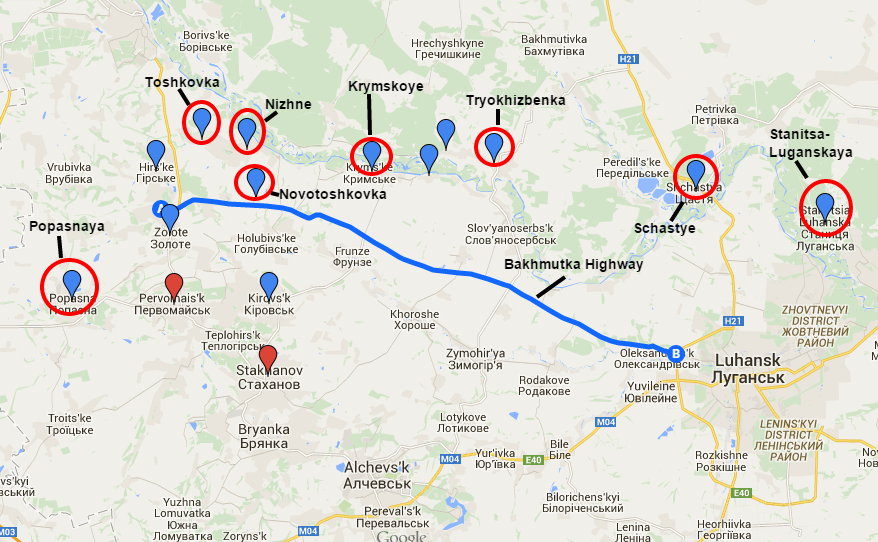
The shellings are the latest in a series of attacks on both civilian settlements and Ukrainian military positions near the highway. There has been almost daily shelling since mid-October.
— Pierre Vaux